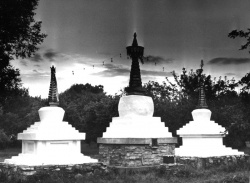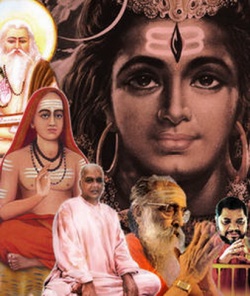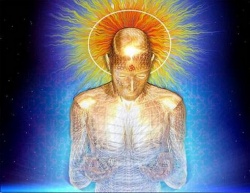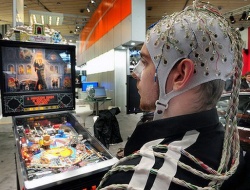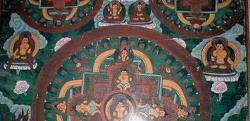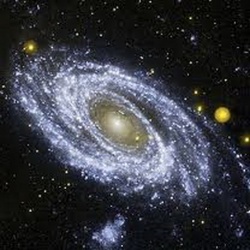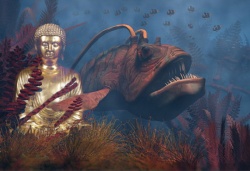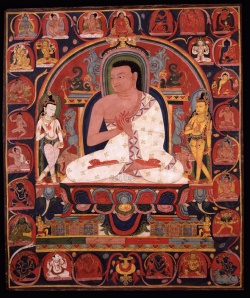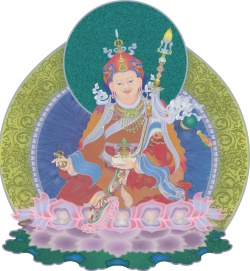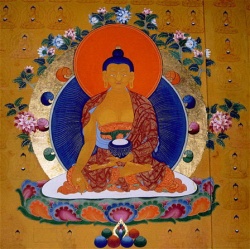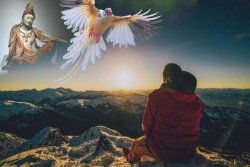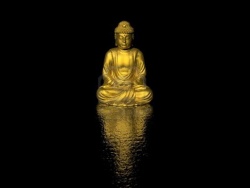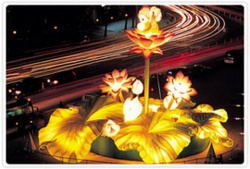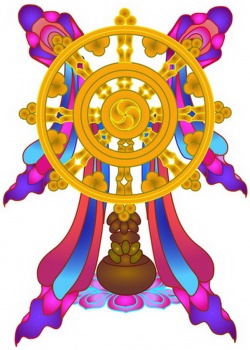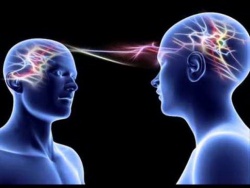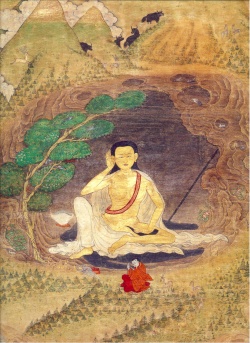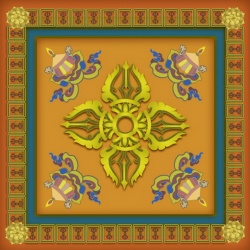Time and Emptiness in the Chao-Lun
Introduction
The Chao Lun(a) (Book of Chao) was written in the early fifth century, c.e., by the Buddho-Taoist monk Seng-chao(b) (378-414)(1).
The book itself contains four essays, the most purely philosophical one is entitled "On Time."(2)
This paper will focus on this essay in order to explain Seng-chao's conception of time and its relation to Buddhist emptiness.
Before this critical analysis can begin, it will be necessary to explain some of the structural aspects of the Chao Lun.
Seng-chao often quotes directly from the ancient classics, the Tao-te-ching(c) and the Chuan Tzu.(d) Taoist technical terms are often cited and used as euphemisms for Buddhist concepts.(3)
There are two important terms of which we should be aware: one, "emptiness" or sunyata is often equated with pen-wu(e) or "original non-being" (this is further associated with Lao Tzu's "Void filled to the brim," that is, the Void that carries all existence within it) and two, the Way or the tao(f) can stand for marga or path.
This latter term is extremely important to Seng-chao.
Seng-chao's book can be understood as his attempt to explain how he views the Buddha's doctrine of the Middle Path.
We can further say that Seng-chao is definitely a Madhyamika Buddhist because he understood some of the basic Buddhist concepts, such as, sunyata, the Middle Path, and Nagarjuna's tetralemma (of which his understanding progressed throughout the period of his writings).
The Middle Path which is classic to all Buddhism explains how to avoid the extremist positions of eternalism and nihilism.
Seng-chao's writings were not intended to argue the truth or validity of the Middle Path; rather much of the Chao Lun was written to explain how an Enlightened Being (the Sage, the Holy Man,or the Buddha) experiences reality.
Seng-chao was not necessarily attempting to prove any ontological or epistemological claims about reality.
The structure of the Chao Lun which itself was compiled after Seng-chao's death by his disciples, is in a reversed chronological order, with the exception of the fourth chapter.
In other words, the first chapter, "On Time," was written after chapter two, "On Sunyata," and chapter three, "On Prajna Not Cognizant."
The latter was the first written essay of the Chao Lun.
An interesting aspect of chapter three is that it includes a set of correspondences between Seng-chao and a fellow monk, Liu I-Min.
These letters shed much light on what Seng-chao thought prajna or enlightenment meant for the Sage.
The last chapter which is of dubious authorship(4) is entitled "Nirvana Is Unnameable."
Another aspect of the Chao Lun is that Seng-chao attempted to use the logic of the tetralemma, though he was not always successful.(5)
There is also a heavy reliance on the language of paradoxes.
This latter will be discussed below for it plays a role in Seng-chao's conception of time.
The goal here will be to explicate the argument in the first chapter regarding the nature of time by paying special attention to the implications of the second chapter's discussion of sunyata.
In order to proceed properly, Seng-chao's understanding of the limitations of language's ability to express his doctrine on time will be discussed.
Our overall treatment of his project will be concerned with the content rather than the actual logical (tetralemmical) structure of Seng-chao's ideas.
Language and Limits
Seng-chao understood that language has certain inherent limitations.
He considered language to be an artificial application of names to things. "Normal language is unable to describe [[[Seng-chao's]] or the Sage's] vision of the cosmos and that therefore contradictions are unavoidable."(6)
Absolute Existence or "Reality belongs to an order that is fundamentally incommensurable with symbolic systems such as language.
Nevertheless, language performs a function in establishing this very truth."(7) Seng-chao knew that he had to use language to make himself understood, but at the same time he realized that language could only establish conventional truths which are, at best, the complementary aspects to the Absolute Truth of the Middle Path.
He was therefore aware of the limited conventional means he had access to in describing Absolute Truth.
He also " seems to have been aware that even an ideal language(8) would correspond only to a conventional interpretation of reality, and not [[[absolute reality]]] itself."(9)
The "ideal" language which most concerned Seng-chao was the "doctrine of names."
Seng-chao explicitly discusses language and the "doctrine of names" in part II, "On Sunyata" (whereas in part I, he treats language as a necessary limitation).
In regard to names and reality he states,
A thing called up by a name may not appear (as what is expected to appear) a name calling up a thing may not lead to the real (thing).
Therefore the sphere of absolute Truth is beyond the noise of verbal teaching.
How then can it be made a subject of discussion without paradox and contradiction (10)
An example of this type of paradox is in Seng-chao's discussion of permanence (rest) and impermanence (motion).
What people call permanence I [[[Seng-chao]]] call impermanence and vice versa.
But then impermanence and permanence, though seemingly different, are ultimately the same.
That is why it is said in a classic [[[Tao-te-ching]] chapter 78]: 'True words seem contradictory. Who dares trust them?' These words are fraught with meaning.(11)
We see in this context Seng-chao drawing upon his Taoist cultural heritage in order to explain the concepts of Buddhism.
Ordinary language is simply unable to describe the ontological truth of reality, of sunyata.
Therefore even an "ideal" language could not accomplish this, for it is only a more "precise" form of conventional language insofar that it describes the conventional world with possibly more exactness.
However, an "ideal" language still functions in an artificial manner:
The 'doctrine of names' is that names [[[Wikipedia:linguistic|linguistic]] entities] match things [[[phenomenal]] entities] and things match actuals [[[noumenal]] entities? .
Seng-chao, like Kumarajiva and Nagarjuna, denies this, and asserts that names are 'borrowed' to designate things and actuals.
Thus they are counterfeit, and do not succeed in designating what is true. Things (phenomena) are the appearances of actuals, but like a phantom are not what they seem, and are thus not real or absolute things.(12)
Language then, no matter how accurate or exact, cannot provide a description or designate absolute truth, for this truth
-is outside the sphere of the 'doctrine of names',
-is referred to by the statement that the dharmas are not existent and not inexistent,
-is asserted to explain 'not inexistent',
-is realized without blanking out images of the myriad things from the mind,
-and in it there is no achieving and no attaining.
It coincides with popular truth in the essential nature (emptiness) of its referents.(13)
Seng-chao's conception of the Middle Path includes the limits of language, sunyata ("not existent and not inexistent") , prajna ("without blanking out images" from part III), enlightenment ("no achieving and no attaining" through sunyata and prajna), and the TwoFold Truth (both "conventional" and "absolute").
The Two-Fold Truth incorporates the limited knowledge (vijnana) which is provided by language and the penetrating insight of enlightened wisdom (prajna) that is independent of language (i.e. alinguistic).
At this point a disclaimer is necessary in regard to the role that sunyata plays in Seng-chao's doctrine on time.
"It is noteworthy that the term does not occur in Chao Lun part I.
Also] there are very few references to the Holy One, and little attention is paid to the soteriological themes that are so prominent" (l4) in the rest of the book.
Exactly why Seng-chao neglected to include these aspects throughout the essay can only be a matter for conjecture. But it is obvious that these ideas are his basic presuppositions.
He did not consider "On Time" to present its ideas in an intellectual and experiential vacuum, that is, without a background of complementary Buddhist ideas and experiences.
In other words, the essay is Madhyamikan, and its tenets are the essay's philosophical foundations, even though they are not explicitly presented in this way.
So we can see how important language's limits are for Seng-chao.
These limits have ramifications for his doctrines and beliefs.
Language shapes his ideas and he recognizes its effects on his thinking.
Language forces his theory of time into paradoxes and contradictions because of its inherent inability to describe true reality.
The truth of the world is necessarily hidden from language, for language divides and discriminates that which, when seen from the enlightened point of view, is essentially interdependent and empty.
The limitations of language prevent it from adequately describing time and sunyata in their undifferentiated and relationally originated fullness of existence.
Time and Emptiness
Seng-chao is said to have known the Madhyamika doctrine on time (15) and that his Mahayana philosophical views were the first indigenous Chinese Buddhist system of its kind.(16)
We will thus proceed to explore Seng-chao's understanding of time.
Perhaps it may have been an idea that be culled from Nagarjuna's Middle Stanzas:
If present and future depend on the past, then present and future should exist in past time
If present and future do not exist in it, how can present and future exist in dependence on it?
The establishment of the two does not occur without dependence on the past,
Therefore, present and future time do not exist.
By this method the remaining two [times] are to be treated mutatis mutandis.
One should examine the top, bottom, and middle, etc., and the oneness, etc.
Non-abiding time is not perceived, and abiding time does not occur;
How can imperceptible time be designated?
If time depends on an entity, where is there time without an entity?
No entity exists, so where would time exist?(17)
Nagarjuna's text demonstrates that it is absurd to think of time as three isolated self-existent entities (svabhava) The underlying assumption here of sunyata or emptiness is evidenced by the phrase "no entity exists."
The same assumption occurs in Seng-chao's essay, but unlike Nagarjuna, his temporal terms do not always follow one meaning.
He shifts positions sometimes, and takes extreme positions in order to explicate how absolute truth appears to the Sage.
This shifting of thought is exemplified in one of Seng-chao's commentaries on the Great Perfection of Wisdom Treatise. He states,
Present dharmas flow quickly and do not abide. What do you consider as arising? If arising and ceasing are at one time, then the two marks [or two actions of arising and ceasing] are both destroyed.
If arising and ceasing are at different times, then at the time of arising there is no ceasing, then dharmas do not have the three marks [[[arising]], ceasing and destruction].
If dharmas do not have the three marks, then they are not conditioned.
If they have all three marks, then there is the error of infinite regression. This statement of no-arising is also furnished in the [Middle] Treatises... The three times are inexistent...(18)
This commentary was Seng-chao's early explanation of time. It was written before the first chapter of the Chao Lun.
Let us turn then our attention to his compiled work.
The statement, "Present dharmas flow quickly and do not abide," is almost completely at odds with his opening tenet in "On Time." He begins that latter essay by declaring that it is wrong to say that things glide along and move; literally, "things cannot alter their positions in the temporal order."(19)
He continues in this vein, further developing what he said in his previous commentary in regard to arising and destruction.
"There is rest (ching(g)) with motion (tung(h)) going on; therefore, though (things) move they are forever at rest.
Motion need not cease in order to produce rest, therefore, though (things) are at rest they do not cease moving."
(20) Motion and rest, just like arising and destruction, are considered to be simultaneous.
These Taoist terms and paradoxical structures exemplify how Seng-chao draws upon his own intellectual background in order to explain Buddhist ideas, which in this case are the permanent and impermanent aspects of emptiness.
In other words, rest or "stillness is the mode of things in essential voidness [[[emptiness]], sunyata].
Since everything is void [or empty] nothing is incompatible with stillness, not even motion.
Motion is compatible with stillness, and the more profound the stillness of essence, the more powerful the action of the function," (21) or motion.
Seng-chao is thus adhering to Taoist "original non-being" or more precisely, Buddhist emptiness, when he states paradoxical or contradictory postulates regarding motion and rest.
Additionally there is a spatial metaphor which Seng-chao has in mind when he says that "things cannot alter their temporal position." Dharmas are arranged in short sequences, santanas; the totality of these form the phenomenal world of experience (samsara).
Samsara is the realm of suffering and self-ignorance where the unenlightened being develops attachments to the elements of desire and passion, and therefore cannot escape the interminable cycles of the wheel of life-death; it is not true reality.
In absolute reality (nirvana) nothing happens, nothing moves, all is empty, dharmas have no "self-existence" and therefore cannot move among the time periods.
Only an Enlightened Being would experience this "suchness" of existence for what it absolutely is, wherein samsra is nirvana.(22)
Thus reality is motionless and "motion-full."
However, this is not a completely correct formulation of Seng-chao's Middle Path.
Fung Yu-Lan states this more accurately according to the Buddhist tetralemma:
What are popularly spoken of as movement and quiescence [rest] do not basically involve an antithesis.
The true aspect of things (dharmas) is that they are neither in movement nor quiescence. Or, to put the matter another way, they are both in movement and quiescence.
To use the formulation of the Buddhist theory of the Middle Path: By saying that there is either movement or quiescence, we fall into the two 'border' or extremes. By saying that there is neither movement nor quiescence we follow the Middle Path.(23)
In other words, the "positive affirmation or negation of two opposing extremes does not really capture the meaning of the Middle Path.
The two extremes must also be avoided. This is meant to prevent a person, specifically the Sage, from establishing a point of view.(24)
The attainment of no point of view is one aspect of enlightenment (nirvana).
Seng-chao next takes up what he believes to be the common conception of time.
His views here describe the nature of the moment in time. "From the fact that what once has been cannot join what is now, [[[ordinary people]]] infer that things move. So they say: they move and are not at rest.
From the same fact, namely, that what is past cannot join the present, I [[[Seng-chao]]] infer they [things] are at rest" (25) in the past.
The phrase "cannot join the present" assumes that each dharma fills its moment (ksana) completely, there is no room or space left for another to come and occupy it simultaneously.(26) This can be said in another way:
People know that what is past cannot come back to the present, and they think that what is now can pass over to the past, whereas Seng-chao says that what is in the past must occupy its position, just like what is now— for where would the "now" go to if it did pass over to the past that is "filled"?
"Each event pertains to one moment of occurrence, with which it is inalienably associated. Seng-chao [and Nagarjuna take] it as an unexpressed axiom that no [singular] event occurs at two different moments."(27)
Within the purview of Seng-chao's view of the moment, we shall turn to his ideas regarding cause and effect.
Liebenthal claims that these ideas are the core teachings of Seng-chao's thought; so, in order to discuss tbese ideas, a full citation of the text will be necessary.
Premises:
-In the following it is proved that causes are unable to produce a result and therefore are always still able to produce one.
Two moments, the cause-moment and the result-moment, must be distinguished. Then two propositions [A and B] are possible.
-A: The result does not exist simultaneously with the cause.
-B: The result is produced by the cause (existing simultaneously with it).
Conclusions:
-From B: If the result is produced by the cause, then the cause has not died in the first (past) moment.
(This means that it is present in the second and takes all the space which should be reserved for the result. Thus the result cannot be produced.)
-From A: If the result does not exist simultaneously with the cause, then the cause (must have died in the first, past moment.
Thus it) cannot come forward to the second (present) moment (in order to produce the result, and thus this cannot be produced.)
-(The impossibility of causation is proved for both cases.)
-Thus, because (the cause) neither dies (in the first or past moment,...B), nor comes (forward to the second or present moment,...A), it is proved that it does not move (from its position in the karmic [or temporal] sequence). (28)
With respect to the very first claim about production of results by causes, both Robinson and Liebenthal agree that Seng-chao misunderstood Nagarjuna on this point.
Robinson claims that Nagarjuna maintained a consistent point of view that "non-abiding time is not perceived and abiding time does not occur...
If time depends on an entity, where is there time without an entity? No entity exists, so where would time exist?" (cited above) Whereas Seng-chao "films the same scene with two different cameras,"(29) insofar that causes can and cannot produce results which Nagarjuna understands as not existing.
Liebenthal, on the other hand, believes that "while Nagarjuna concludes from the immutability of the causes that they cannot produce a result, Seng-chao believes that Nagarjuna wishes to prove their immutability.
He silently infers: causes are immutable, therefore not yet exhausted [in the result-moment], therefore still effectability" means to Seng-chao, (31) for Seng-chao denies the movement of dharmas from one moment (ksana) to another.
Therefore, in saying that a cause is still effective, Liebenthal implies that it endures or abides beyond its temporal position so as to exist in another position.
This is not, according to Robinson, what Seng-chao means.
For Seng-chao, ordinary causation does not operate through a shift of entity from one point to another.
In modern terms, he considers causation as a relation between events rather than as an event.
The Tathagata, the Holy One, identifies with the self-voidness-the nature-of all the dharmas.
Thus he is all-pervasive, all knowing, and able to exert influence without acting, that is,without shifting from one point to another.(32)
In considering "causation as a relation" in modern terms, a comparison between the conception of causality of empiricist and sceptic, David Hume, and Seng-chao's doctines will aptly illustrate this point.
Hume comes from a different background than Seng-chao, therefore his premises and philosophical goals are quite distinct from those of the Buddho-Taoist monk. At most points their views are oppositional, but, suprisingly enough, they arrive at very similar conclusions.
Hume considers causality to be only an assumed idea that is inferred from our experiences of real objects which can either be of an internal or external nature. Cause and effect are on this basis seen as products of our understanding. He states:
One event follows another; but we never observe any tie between them. They seem conjoined, but never connected. And as we can have no idea of anything which never appeared to our outward sense or inward sentiment, the necessary conclusion seems to be that we have no idea of connexion or power at all, and that these words are absolutely without meaning, when employed either in philosophical reasonings, or common life.(33)
In other words,
Had not objects a regular conjunction with each other, we should never have entertained any notion of cause and effect; this regular conjunction produces that inference of the understanding, which is the only connexion, that we can have any comprehension of. (34)
Hume wishes to deny that there are any necessity, a priori, powers or reasons, which produce causes and effects.
Rather causes and effects are what we infer through our observations of the uniformity of experiences over time, and so we establish customs or habits based on empirical experimentation and evidence.
These provide us with an understanding of how causality functions in the world.
We can conclude that because we cannot directly experience or observe the causes that we infer between objects or events then causality does not (necessarily) exist in reality.
It is only a customary assumption which our understanding leads us to create and follow.
In comparison to Seng-chao, Hume adheres to the self-existence (svabhava) of entites and objects, whereas Seng-chao understands them to be empty and non-self-existent.
Where Hume refers to the uniformity of experience, Seng-chao sees, oppositionally, the constant impermanence of things in experience, and only uniformity is the permanence of sunyata.
Possibly, Seng-chao might agree that cause and effect as inferred by the understanding (or cognizing mind) would be the common or ordinary people's conception, but he would maintain that this is not how the Sage or the Enlightened Being would experience reality.
In sum, Hume's claim that there is no necessary or a priori connection between events and objects would indeed agree with Seng-chao's conclusion of the "impossibility of causation." However, we still need to explicate the relation between causality and sunyata.
Seng-chao's understanding of the experiential notion of sunyata, a key concept in Buddhist thought,(35) grounds his doctrine on time.
Sunyata indicates the relational nature of the experiential world.
The Sanskrit term pratitya-samutpada ("relational origination") describes the mutual interdependence and interpenetration of all the elements of experience; its realization was the core of the historical Buddha's enlightenment.
No particular thing existed, exists, or comes to exist in isolation from the rest of the world.
Any "isolation of a thing" is an abstraction which can be reified into an "absolute or self existence" by the cognizing mind.
(Such abstractions are, in part, the product of language.)
The cognizing mind treats the isolated and individual thing as if it had svabhava or "Self-existence."
So the mind can grasp after or desire the self-existent entity. Attachments to these desires are the sources of suffering (duhkha) and ignorance.
It was the nature of the Buddha's enlightenment to pierce this veil of "absolute" (self) ignorance of existence, thereby obtaining the experiential state wherein no thing has a self-nature (svabhava) or independent existence.
Without self-existence, everything must be considered empty and void, for artificially isolated and abstracted entities (via the cognizing mind and language) must depend on other entities for their very (own) existence.
An isolated thing does not exist absolutely, for things only exist relatively in the general flux of reality.
The enlightening experience of pratitya-samutpada cannot be fully explained in linguistic terms because it is an existential or (pure) ontological truth of the world, and can therefore only be found in the truth of sunyata, in experience which is relational and impermanent.
The limits of language, time, emptiness, and the Middle Path are all inextricably bound together for Seng-chao.
To analyze his doctrine of time in any other manner would inevitably lose sight of his more fundmental philosophy and Buddhistic understanding of experience reality
Conclusion
We have seen how the idea of emptiness is a component of Seng-chao's doctrine of time. His ideas are not completely Buddhistic, but we can definitely see the Madhyamikan strain in his thought.
His doctrine of time can also be seen as an elaboration of Nagarjuna's idea of time.
Nagarjuna concluded that time was non-existent, but by following some of the ideas of Seng-chao, a further development of the concept of time is possible.
Since all three periods of time (past, present and future) are dependent on each other, to consider any isolated time period as having independent existence is an erronenous position.
The interdependence of time periods points to the idea that these aspects of time are empty.
Since time itself is the source of change, the very non-abidingness that we experience (which cannot be explicated with language), an ontological and necessary relation between emptiness and change is obvious.
Thus, if we were to take the phrase '"sunyatam sunyata" which means to "empty emptiness (of self-nature) — that is, to understand that emptiness is not an entity — and apply this phrase to time, we can empty time itself, not only of its existence, but its non-existence as well.
This would expand on Nagarjuna's original conclusion by using some of Seng-chao's ideas. But such an argument would take us too far afield and will have to be addressed at another time.
Notes
1. Liu, Ming-wood, "Seng-chao and the Madhyamika Way of Refutation," Journal of Chinese Philosophy, (March 1987), 97, as opposed to Fung YuLan's A History of Chinese Philosophy, D.Bodde, trans., (Princeton: Princeton University Press, 1953)which claims the dates as 384-414 (p. 258).
2. Robinson, Richard H., Early Madhyamika in India and China(Madison: University of Wisconsin Press, 1967) p.146.
3. Fung Yu-Lan, A History of Chinese Philosophy p.258, and Conze, Edward, A Short History of Buddhism (London: George Allan and Unwin,Publishers, Ltd., 1980), p.67.
4. Liebenthal, Walter, translator,Chao-Lun, (Book of Chao), (Hong Kong. Hong Kong University Press, Hong Kong 1968 second edition), p.39 and footnote 668 on p.126. This book will be considered as the standard translation of the Chao-Lun.
5. See Robinson Early Madhyamika, ch. VI. He spends a great deal of his effort in analyzing the logical structures of Seng-chao's arguments. I cannot help but feel that Robinson has missed some crucial aspects of Seng-chao's writings because to a great extent they are more qualitatively mystical than quantatively logical.
6. Liebenthal,Chao-Lun. p.60, footnote 224. p.57
7. Robinson,Early Madhyamika,p.120.
8. Possibly a modern equivalent to what might have been an 'ideal language' for Seng-chao might be found in the writings of Bertrand Russell, Ludwig Wittgenstein's Tractatus Logico-Philosophicus, or the logical positivists-like Herbert Feigl.
9. Robinson,Early Madhyamika,p.111.
10. Liebenthal,Chao-Lun,p.56.
11. Liebenthal,Chao-Lun,p.51.
12. Robinson,Early Madhyamika,p.144.
13. Robinson,Early Madhyamika,p.143 slightly modified.
14. Robinson,Early Madhyamika,p.146.
15. Robinson,Early Madhyamika,p.138.
16. Conze,A Short History of Buddhism,p.69.
17. Robinson,Early Madhyamika,p.150.
18. Robinson,Early Madhyamika,p.138.
19. Liebenthal,Chao-Lun,p.45.and footnote 128.
20. Liebenthal,Chao-Lun,p.46.
21. Robinson,Early Madhyamika,p.129.
22. Liebenthal,Early Madhyamika,p.46.
23. Fung Yu-Lan,A History of Chinese Philosophy,p.263.
24. This ancient Buddhist ideal of "no point of view" was given a more structured treatment in Fa-tsang's Hua-Yen Buddhism three hundred years later. See Cook Francis, H., Hua-Yen Buddhism (University Park: Pennsylvania State University Press, 1977, third edition), particularly chapters 1,4,5, 6,and 8.It should also be noted that this ideal is also an aspect of other mystic traditions which attempt to describe similiar transcendental experiences. So Buddhist prajna and Augustine's Love will have similar characteristics.
25. Liebenthal,Chao-Lun,p.47.
26. Liebenthal,Chao-Lun,p.47, footnote 141.
27. Robinson,Early Madhyamika,p.149.
28. Liebenthal,Chao-Lun,p.52-53. I have slightly restructured the argument as translated by Liebenthal in order that it may be more acessible for analysis.
29. Robinson,Early Madhyamika,p.150.
30. Liebenthal,Chao-Lun,p.52 and footnote 165.
31. "What Seng-chao calls 'immutability' (pu-ch'ien(i)) is a mystical concept that transcends both quiescence (ching(g) ) and movement (tung(h) ) as ordinarily conceived. According to his theory, each event and thing is forever fixed in the particular flash of time to which it belongs.Yet the succession of these flashes creates the illusion that a process of movement is taking place, just as the successive images on a strip of moving picture film give the illustration of movement, even though each of these images is in itself static and remains forever distinct from the other images." Fung Yu-lan, A History of Chinese Philosophy, p.264,footnote 1.
32. Robinson, Early Madhyamika,p.150
33. Hume, David, An Enquiry Concerning Human Understanding, Eric Seinberg, editor, (Hackett Publishing Company, Inc, Indianapolis 1977), p.49.
34. Hume, An Enquirly, p.64
35. Nagao, G. M. Madhyamika and Yogacara, L. S. Kawamura, trans., (State University of New York Press, Albany 1991), p.64 specifically, as well as other cited references in the book's index for more particulars
